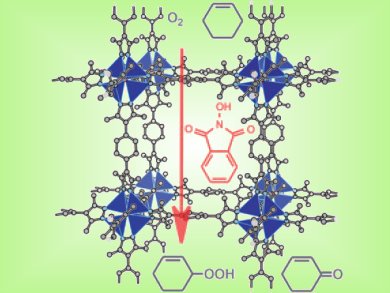Porous metal–organic frameworks (MOFs) are finding use in catalysis due to their heterogeneous nature and large surface area. For MOFs with catalytic sites at the nodes, examples of redox catalysis are rare. And the question of whether the catalysis is truly heterogeneous or results from leaching of metal ion has not been addressed.
Dirk Volkmer and colleagues, Augsburg University, Germany, have compared two MOFs. MFU-1 and MFU-2 both contain redox-active CoII centers coordinated by linear ligands. MFU-1 performs as a truly heterogeneous and robust catalyst. MFU-2 shows a similar catalytic activity but suffers from metal leaching into solution.
MFU-1 could be used to oxidize a range of organic substrates by impregnating it with N-hydroxyphthalimide. The heterogeneous oxidation reactions employed molecular oxygen from air and could be performed under ambient conditions.
Image: © Wiley-VCH
- Pyrazolate-Based Cobalt(II)-Containing Metal–Organic Frameworks in Heterogeneous Catalytic Oxidation Reactions: Elucidating the Role of Entatic States for Biomimetic Oxidation Processes
M. Tonigold, Y. Lu, A. Mavrandonakis, A. Puls, R. Staudt, J. Möllmer, J. Sauer, D. Volkmer,
Chem. Eur. J. 2011.
DOI: 10.1002/chem.201003173




